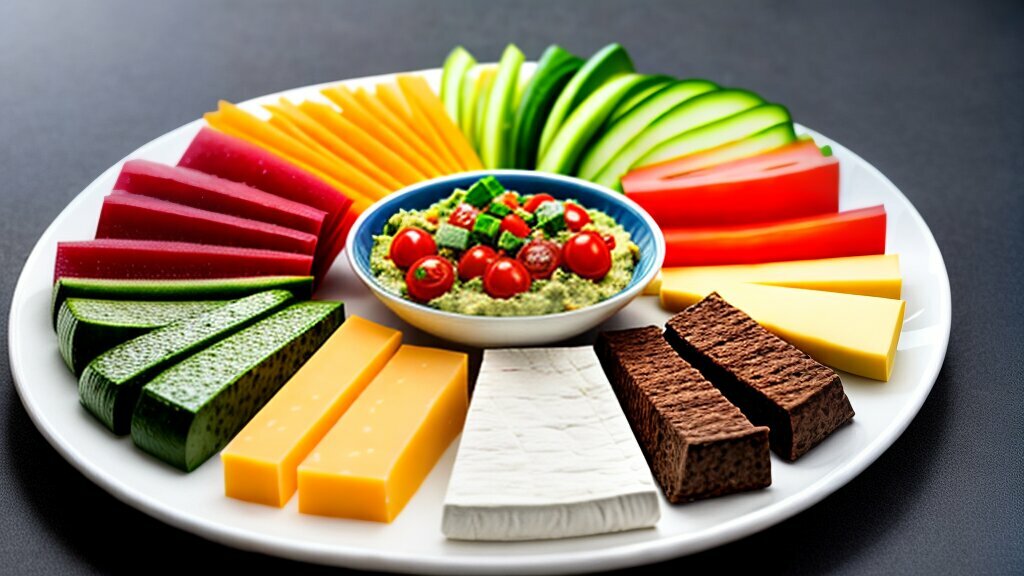Welcome to your ultimate guide to low-carb diet tips for Australians. If you’re looking to improve your health, manage your weight, or simply adopt a healthier lifestyle, a low-carb diet could be just what you need. In this comprehensive guide, we will discuss the benefits of a low-carb diet, offer tips on how to incorporate low-carb foods into your meals, provide advice on snacking the low-carb way, and much more. So let’s get started!
Key Takeaways:
- A low-carb diet can offer numerous benefits for Australians
- Understanding the concept of a low-carb diet and choosing the right one for individual needs is important
- Incorporating low-carb foods into your meals is easier than you may think
- A low-carb diet can aid in weight loss, improve energy levels, and offer better blood sugar control
- Staying committed to a low-carb lifestyle is achievable with the right strategies and mindset
Understanding the Low-Carb Diet
If you’re new to the low-carb diet, it’s important to understand the concept and how it can benefit your health. The low-carb diet involves reducing your intake of carbohydrates, such as sugar and starch, and increasing your intake of protein and healthy fats. This approach can help you lose weight, improve energy levels, and control blood sugar.
There are many popular low-carb diets, including the Atkins, South Beach, and ketogenic diets. Each of these diets has its own approach to carbohydrate restriction and specific guidelines to follow. When choosing the best low-carb diet for your needs, consider your health goals, lifestyle, and food preferences.
Understanding the Low-Carb Diet
| Diet Name | Approach to Carbohydrate Restriction | Guidelines |
|---|---|---|
| Atkins | Gradually increase carbs over time while maintaining weight loss | 4 stages, beginning with 20g of carbs per day |
| South Beach | Gradually reduce carbs in 3 phases | Phase 1 limits carbs to 20g per day |
| Ketogenic | Extremely low-carb diet that puts your body into ketosis | 20-50g of carbs per day, with an emphasis on healthy fats |
No matter which low-carb diet you choose, make sure to consult with a healthcare professional before starting and follow the guidelines closely to ensure proper nutrition and avoid any potential health risks.
Incorporating Low-Carb Foods into Your Diet
Now that you have a good understanding of low-carb diets, it’s time to start incorporating low-carb foods into your diet. By making a few simple changes to your meals, you can enjoy the benefits of a low-carb lifestyle while still enjoying delicious, satisfying food.
Best Low-Carb Foods to Incorporate
Some of the best low-carb foods to incorporate into your diet include:
| Food Group | Low-Carb Options |
|---|---|
| Protein | Chicken, eggs, turkey, beef, pork, fish, tofu |
| Fruits and Vegetables | Leafy greens, broccoli, cauliflower, zucchini, berries, avocado |
| Dairy and Dairy Alternatives | Cheese, plain Greek yogurt, almond milk, coconut milk |
| Fats and Oils | Coconut oil, olive oil, butter, nuts, seeds, nut butter |
Low-Carb Meal Ideas
Here are some meal ideas to get you started:
- Grilled chicken with roasted vegetables
- Salmon with avocado and a side salad
- Low-carb stir-fry with tofu, broccoli, and mushrooms
- Hard-boiled eggs with sliced cucumber and hummus
- Bunless burger with a side of grilled vegetables
Healthy Low-Carb Options
There are many healthy low-carb options that are easily available in Australia. Some of these include:
- Low-carb protein bars (look for options with minimal added sugars)
- Low-carb wraps (made from coconut or almond flour)
- Low-carb bread (made from seeds or nuts instead of grains)
- Low-carb pasta (made from chickpeas or lentils)
- Low-carb tortilla chips (made from almond or coconut flour)
Remember to always read food labels carefully and choose options with minimal added sugars and carbohydrates.

Benefits of a Low-Carb Diet
A low-carb diet has numerous benefits that can improve your overall health and well-being. Here are some of the top benefits of following a low-carb diet:
| Benefit | Description |
|---|---|
| Weight loss | Low-carb diets have been shown to be effective for weight loss because they reduce cravings and appetite, leading to a decrease in calorie intake. |
| Better blood sugar control | Reducing carb intake can help regulate blood sugar levels and improve insulin sensitivity, which is especially beneficial for those with diabetes or pre-diabetes. |
| Improved energy levels | Low-carb diets can boost energy levels by stabilizing blood sugar and reducing the need for frequent snacking. |
| Reduced inflammation | Studies have shown that low-carb diets can help reduce inflammation in the body, which is linked to various chronic diseases. |
By reducing your carb intake and increasing your intake of healthy fats and proteins, you can improve your overall health and well-being. Keep in mind that everyone’s body is different, and the results of a low-carb diet may vary. It’s important to consult with your healthcare provider before starting any new diet or exercise program.

Low-Carb Diet Tips for Weight Loss
Looking to lose weight on a low-carb diet? Here are some practical tips to help you achieve your weight loss goals:
- Practice portion control: Even though low-carb diets allow more fat and protein, portion control is still important for weight loss. Use measuring cups, a food scale, or visual aids to help you stick to appropriate portion sizes, and avoid going back for seconds.
- Make smart food choices: Choose high-quality, nutrient-dense foods that make you feel full and satisfied. Examples include leafy greens, non-starchy vegetables, healthy fats like avocado and nuts, and lean proteins such as chicken, fish, and tofu.
- Meal prep: Spend some time each week planning and preparing your meals in advance. This can help you stay on track and avoid making impulsive food choices when you’re hungry.
- Experiment with low-carb recipes: There are plenty of delicious low-carb recipes available online. Try some new recipes to keep things interesting, and look for recipes that use whole, unprocessed ingredients.
- Stay hydrated: Drinking plenty of water can help you feel full and reduce cravings. Aim for at least 8 glasses of water per day, and more if you’re exercising or sweating heavily.
Incorporating these tips into your low-carb lifestyle can help you achieve your weight loss goals and improve your overall health. Need some inspiration? Check out this easy low-carb recipe for a tasty and satisfying meal:
| Easy Low-Carb Recipe: | |
|---|---|
 |
|
Remember, weight loss is a journey, not a destination. Be patient with yourself, celebrate your successes along the way, and stay committed to your low-carb lifestyle.
Snacking the Low-Carb Way
Snacking can be a challenge when following a low-carb diet, but it doesn’t have to be. There are plenty of satisfying and nutritious low-carb snacks that you can easily incorporate into your daily routine.
One great option is nuts, which are high in healthy fats and protein, and low in carbs. Almonds, macadamias, and walnuts are all great choices. Just be sure to watch your portion sizes, as nuts are calorie-dense.
| Low-Carb Snack Ideas: |
|---|
| Cheese cubes or cheese sticks |
| Hard-boiled eggs |
| Veggies and dip (such as carrot sticks or celery with hummus) |
| Beef jerky (look for brands with no added sugar) |
| Olives |
| Sliced avocado with sea salt and lemon juice |
| Low-carb protein bars or shakes |
| Homemade trail mix (with nuts, seeds and unsweetened dried fruit) |
If you have a sweet tooth, there are also plenty of options that won’t derail your low-carb diet. A handful of berries (such as strawberries or raspberries) with whipped cream is a delicious and low-carb treat.
Remember, the key to successful snacking on a low-carb diet is to plan ahead and have healthy options readily available. Keep snacks like the ones listed above on hand, so that you’re never caught hungry and without a healthy choice.

Staying Committed to a Low-Carb Lifestyle
Switching to a low-carb diet can be challenging, but don’t let that discourage you from achieving your health goals. Here are some tips to help you stay committed:
- Plan ahead: Always be prepared with healthy low-carb snacks or meals when you’re on-the-go or don’t have access to home-cooked food.
- Stay motivated: Focus on the benefits of a low-carb diet, such as improved energy levels and better blood sugar control. Visualize your goals, and find a support system to help you stay on track.
- Make smart food choices: Choose nutrient-dense, whole foods that are high in fiber and protein. Avoid processed foods and sugary drinks, which can quickly increase carb intake.
- Dine out wisely: Research restaurant menus ahead of time, and ask for modifications to fit your low-carb diet. Opt for dishes with healthy fats and lean proteins, and avoid carb-heavy sides.
- Deal with cravings: When cravings strike, distract yourself with a healthy activity like going for a walk or talking to a friend. Choose low-carb alternatives like berries or nuts to satisfy your sweet or salty cravings.
By following these tips, you can overcome the challenges of a low-carb diet and stay committed to your healthy lifestyle.

Conclusion
By incorporating low-carb diet tips into your lifestyle, you can experience numerous health benefits. From weight loss to better blood sugar control, a low-carb diet can help improve your overall wellbeing.
Remember to choose a low-carb diet that suits your individual needs and preferences. Incorporate low-carb foods into your meals and snacks, and use portion control to ensure you’re not overeating.
Staying committed to a low-carb lifestyle can be challenging at times, but don’t give up. Use the tips provided in this guide to overcome obstacles and stay motivated.
So, what are you waiting for? Start your low-carb journey today and experience the benefits for yourself.
FAQ
Q: What is a low-carb diet?
A: A low-carb diet is a dietary approach that focuses on reducing the intake of carbohydrates while increasing the consumption of proteins and healthy fats. By limiting carbs, the body is forced to burn stored fat for energy, leading to weight loss and other health benefits.
Q: What are some popular low-carb diets in Australia?
A: Some popular low-carb diets in Australia include the ketogenic diet, Atkins diet, and the Paleo diet. These diets restrict carbohydrate intake and emphasize the consumption of high-quality proteins and fats.
Q: How can I incorporate low-carb foods into my diet?
A: You can incorporate low-carb foods into your diet by choosing non-starchy vegetables, lean proteins, and healthy fats. Replace high-carb foods like bread, pasta, and sugary snacks with low-carb alternatives like cauliflower rice, zucchini noodles, and nuts.
Q: What are the benefits of a low-carb diet?
A: Following a low-carb diet can lead to numerous benefits such as weight loss, improved energy levels, better blood sugar control, and reduced risk of chronic diseases like diabetes and heart disease.
Q: What are some low-carb diet tips for weight loss?
A: For weight loss on a low-carb diet, practice portion control, choose whole, unprocessed foods, and focus on high-quality proteins. Additionally, try incorporating easy low-carb recipes into your meals to keep your diet interesting and enjoyable.
Q: What are some low-carb snack options?
A: When snacking on a low-carb diet, opt for foods like nuts, seeds, Greek yogurt, cheese, and low-carb vegetables like cucumber and celery. These options are satisfying, nutritious, and won’t derail your low-carb lifestyle.
Q: How can I stay committed to a low-carb lifestyle?
A: Staying committed to a low-carb lifestyle can be challenging, but it’s possible. Plan ahead, make smart choices when dining out, find healthy low-carb options, and stay motivated by setting achievable goals and rewarding yourself for milestones.
